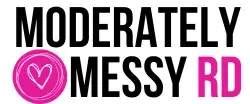Fiber is already one of the most underrated nutrients – add in the extremely popular “low carb” diet and it can be even more challenging to get the recommended 25 grams per day minimum. Prioritize fiber on a low-carb diet with this 5-day meal plan. Each day contains around 100 grams of carbohydrates, over 100 grams of protein, and at least 25 grams of fiber!
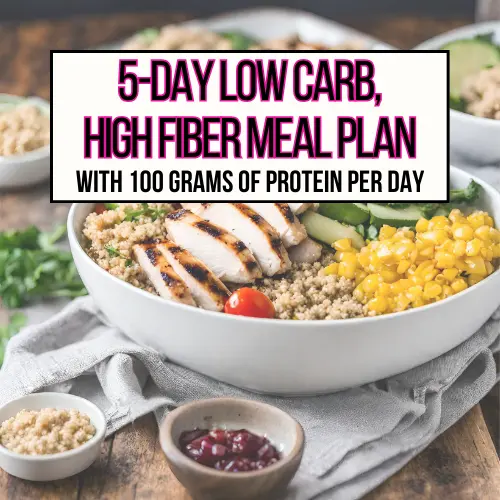
The benefits of fiber have been widely researched. Not only does it help with weight management, but consuming a higher fiber diet can improve our gut microbiome and lower the risk of chronic diseases. If you have diabetes, one of the top suggestions is to increase fiber intake.
It might take a little more preparation and planning in the beginning, but once you are aware of how to build a higher fiber meal it will only benefit you in the long run!
How to Increase Your Fiber Intake
When increasing your fiber intake, aim to eat more fruits, vegetables, whole grains, beans and legumes! Fiber is a non-digestible starch that helps slow down how quickly our food is digested. This means that it has been shown to keep us fuller for a longer period of time while also preventing large spikes in blood sugar.
It is one of the best nutrients to improve gut health, promote bowel regularity, decrease cholesterol, and even reduce the risk of certain cancers. Check out the list below for the best foods to increase overall fiber intake.

Also Read:
— The Benefits of a High Protein, High Fiber Diet (with Meal Plans)
— High Fiber Breakfast Ideas
— The Best Food Swaps for Gut Health
— 35+ High Protein Plant-Based Recipes
5-Day Meal PLan with 100g of Carbs and 25 grams of fiber
Read through these meal plans for increased awareness on how to build your own meals based on your preferences and lifestyle. Most meals will have an explanation on why I included it in the meal plan.
The aim here was ~100 grams of carbohydrates, over 25 grams of fiber and at least 100 grams of protein per day – but quite frankly, it’s a pain in the butt to hit those numbers perfectly. We should never try to be “perfect” anyways.
Nutritional information is just an estimation and individual ingredients and preparation may lead to slight discrepancies. These meal plans are just a guide- some days, the calories are lower than what I would recommend to allow for beverages and other additions.
Day 1
Macronutrient breakdown:
Breakfast: Chia Breakfast Bowl; 400 calories, 22g protein, 41g carbohydrates (15g fiber).
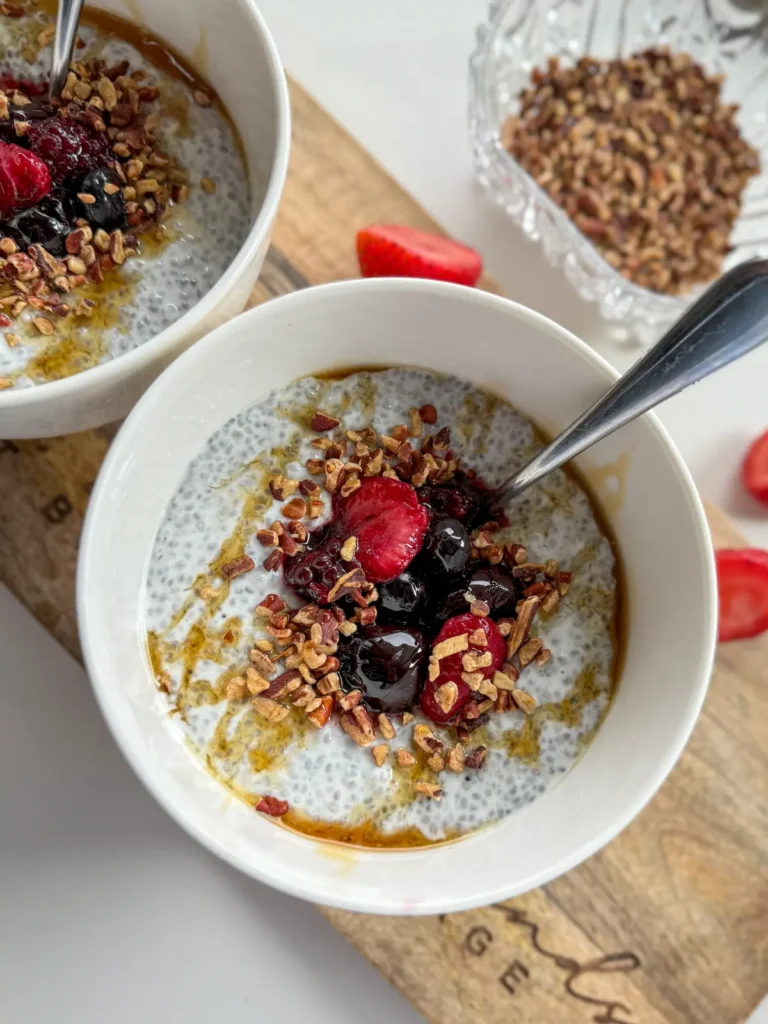
Chia seeds are the ultimate high fiber add-on for any meal! With 10 grams of fiber in 2.5 tablespoons and only 13 grams of carbohydrates per serving. They can easily be added to soups, salads, smoothies, etc.
Lunch: Healthy Taco Salad (Downshiftology): 433 calories, 34g protein, 27g carbohydrate (12g fiber)
Salads are obviously lower in carbohydrates, and this one uses black beans and avocado to up the fiber content.
Dinner: Sheet Pan Baked Chicken Breast with Veggies (Healthy Fitness Meals): 258 calories, 29g protein, 17g carbohydrates (6g fiber).
A simple sheet pan dinner consisting of just baked chicken breast and veggies. Since breakfast was a little higher in carbohydrates, this meal balances out the day as it contains less carbs.
Snack #1: 1 ounce roasted almonds + 2 cups of popcorn; 240 calories, 6g protein, 14g carbohydrates (4g fiber).
Snack #2: Hard-boiled egg; 80 calories, 6g protein, 0g carbohydrates.
Day 2
Macronutrient breakdown:
Breakfast: High Protein Breakfast Burrito; 336 calories, 25.5g protein, 20g carbohydrates (11g fiber)
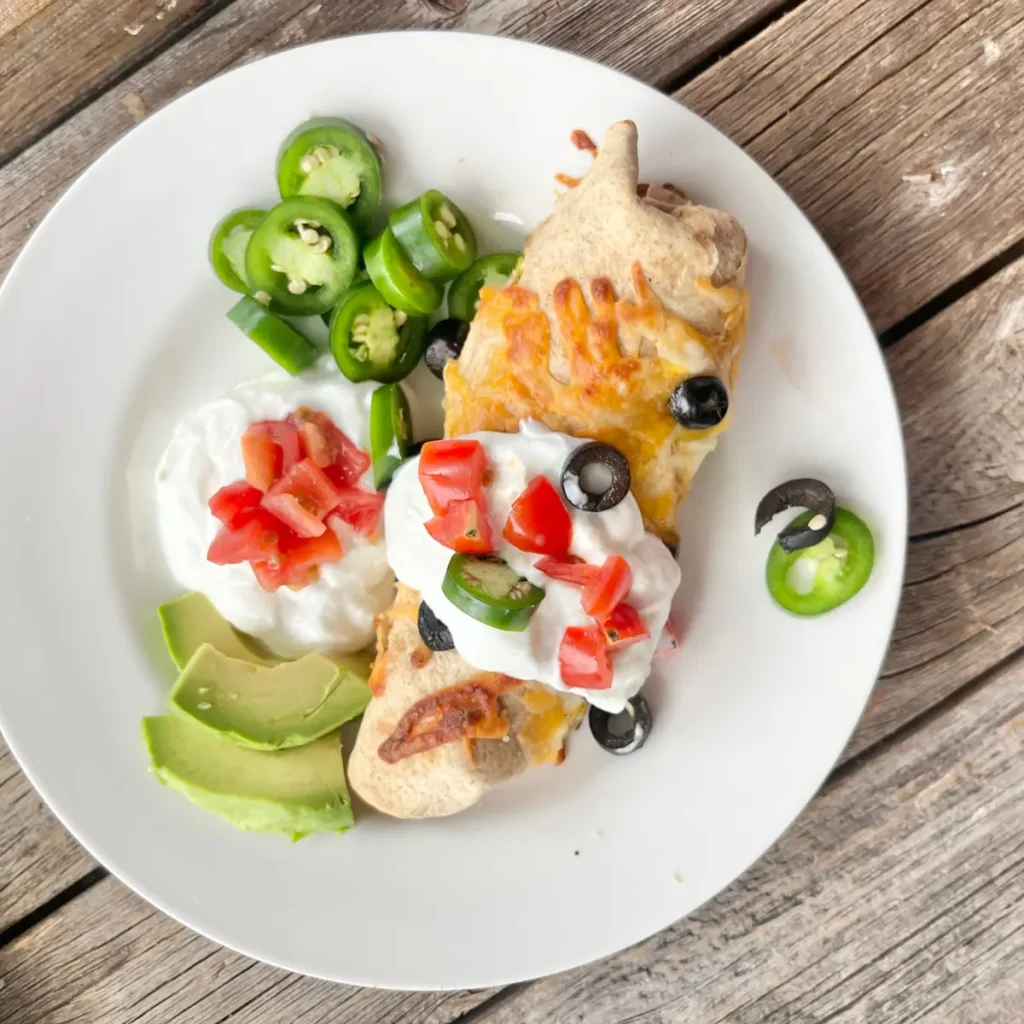
This recipe is packed with flavor and utilizes a low-carb tortilla that’s also higher in fiber. The addition of black beans and avocado increases the fiber content as well. It’s the ideal low carb, high protein breakfast!
Lunch: Honey Mustard Chicken Salad without Mayo (Nourished by Nic): 408 calories, 23g protein, 26g carbohydrates (2g fiber).
A high protein yet low carb chicken salad (dairy-free as well) with a kale slaw.
Dinner: Stuffed Acorn Squash (Well Plated by Erin): 421 calories, 26g protein, 40g carbohydrates (6g fiber)
Acorn squash is an underrated, high fiber vegetable. The squash is stuffed with chicken or turkey sausage, apples, onion and mushrooms for a delicious and nutritious meal.
Snack #1: Celery + 2 tablespoons of peanut butter; 180 calories, 9g protein, 6g carbohydrates (3g fiber)
Snack #2: 1/2 cup of cottage cheese and 1/4 cup raspberries; 130 calories, 15g protein, 10g carbohydrates (4g fiber)
Raspberries contain 8 grams of fiber per 1/2 cup serving – they reign supreme among other berries in fiber content.
Day 3
Macronutrient Breakdown:
Breakfast: Greek Yogurt Parfait; 350 calories, 20g protein, 22.6g carbohydrates (9.8g fiber)
This Greek yogurt parfait was calculated with 1 cup of Greek yogurt, 1/2 cup of mixed berries, 2 tablespoons chopped walnuts, and 2 tablespoons of chia seeds.

Lunch: Loaded Salmon Salad with Creamy Tahini Vinaigrette (Spoon Fork Bacon); 756 calories, 28g protein, 27g carbohydrates (10g fiber).
Salmon is seriously one of the best foods you could possibly eat. It is one of the ONLY food sources of vitamin D and omega-3 fatty acids EPA/DHA. The romaine lettuce, corn, avocados, and peaches contribute to this recipe’s 10 grams of fiber.
Dinner: Mediterranean Grain Bowl (with quinoa); 472 calories, 33.8g protein, 44g carbohydrates (7g fiber).
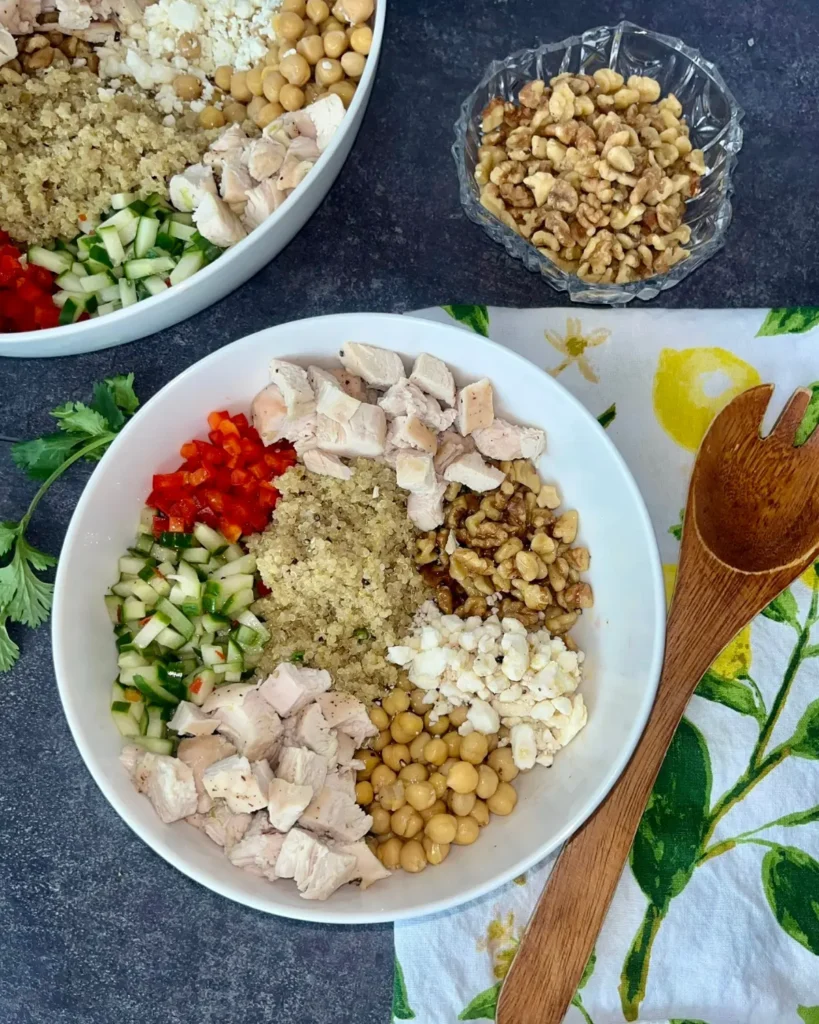
Snack #1: Dark Chocolate Cheesecake Protein Pudding. This is an easy, delicious snack recipe that takes just 5 minutes of prep time.
Snack #2: 1/2 cup of edamame
Day 4
Macronutrient Breakdown:
Breakfast: Savory Quinoa Breakfast Bake; 383 calories, 26.5g protein, 33g carbohydrates (5.6g fiber).
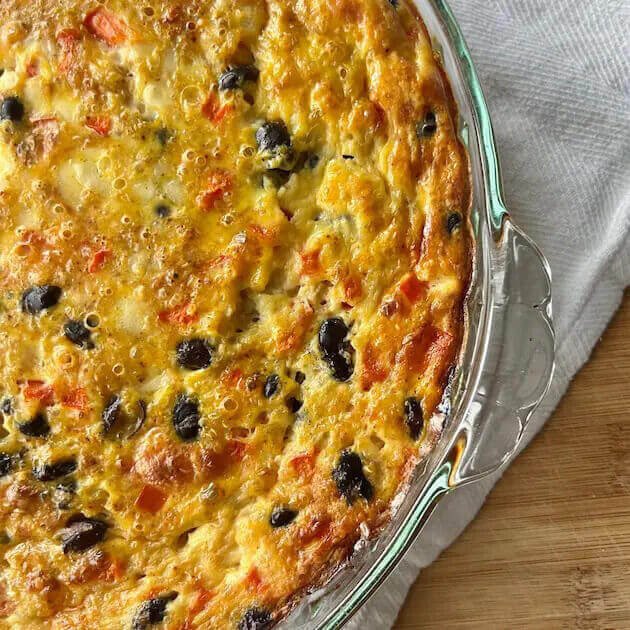
The “superfood” quinoa strikes again – this time for breakfast. It’s an excellent replacement for oatmeal. This recipe is a cross between baked oatmeal and a frittata with Mexican-inspired flavors. Therefore, it has beans (because they’re just so good for you).
Lunch: Hard-Boiled Egg and Turkey Bistro Box (Momables); 296 calories, 29g protein, 15g carbohydrates (4g fiber).
This bistro box is like an adult lunchable with protein-packed hard-boiled eggs and sliced turkey. Add in some high fiber vegetables and it makes the easiest, low-carb lunch.
Dinner: Greek Lentil Salad (Haute & Heathy Living) + 4 ounces Salmon; 540 calories, 38g protein, 35g carbohydrates (13g fiber).
Lentils are an excellent plant-based protein source while also being high in fiber. Add 4 ounces of salmon or chicken to meet the “ideal” protein recommendation of at least 20 grams per meal.
Snack #1: Fairlife Core Power Vanilla Shake; 170 calories, 26g protein, 6g carbohydrates (1g fiber).
Snack #2: 1/2 cup of carrots with Greek yogurt dip; 150 calories, 14g protein, 10g carbohydrates (3g fiber).
Day 5 {Vegetarian}
Plant-based meals are often higher in fiber because they typically contain a lot of fruits and/or vegetables. I included a vegetarian option for those who are vegetarian or wanting to eat more plant-based meals.
This meal plan is way too low in calories – I would double the tofu in the scramble, and add more tempeh for the nourish bowl to increase the calorie and protein content. Even eating two cheesecake cups would work here as well!
Macronutrient Breakdown:
Breakfast: Tofu Scramble (Nora Cooks); 288 calories, 24g protein, 9g carbohydrates (4g fiber).
Lunch: White Bean Veggie Burger (Spa Bettie); 339 calories, 21g protein, 29g carbohydrates (8g fiber).
Dinner: Thai Tempeh Nourish Bowl (Fit Mitten Kitchen); 275 calories, 20g protein, 40g carbohydrates (16g fiber).
Snack: Mini Strawberry Cheesecake Cups; 88 calories, 15g protein, 6g carbohydrates.

Snack: Roasted Chickpeas (Minimalist Baker); 120 calories, 4.6g protein, 14.7g carbohydrates (4.2g fiber).
Hope This Helps!
In all honesty, these meal plans took quite awhile to create. Trying to prioritize fiber and protein while consuming a lower carb diet DOES take more awareness, planning and preparation.
I hope this post helped you understand how to build more fiber into your meals so you can reap all the benefits! Even if meeting that 25 grams per day recommendation isn’t realistic, just adding more fruits, vegetables, beans, legumes and whole grains to your diet can make a big difference.
I personally am not a huge fan of diets with less than 100 grams of carbohydrates per day, but I do understand that low carb diets have become extremely popular – and people have seen great results following them.
